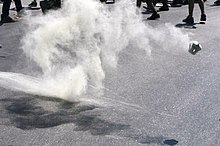Tear gas


Tear gas is the name for a number of chemical compounds. They are not actually gases.[1] They are fine powders or mists of liquid. The chemicals are acidic and cause pain in the eyes. Tear gas may cause temporary blindness for up to 45 minutes. Tear gas is commonly used by police to control crowds. Phenacyl chloride (CN) liquid and CS powder are two of the chemicals that are often found in tear gas. Pepper spray is another chemical compound that acts very similarly and is sometimes used to control crowds.
Tear gas is a chemical weapon, and was used as a weapon in the First World War. The 1925 Geneva Protocol is not specific enough about the use of irritating agents, such as tear gas in war. The Chemical Weapons Convention, of 1992 prohibits the use of tear gas for warfare. The use as a riot control agent is not covered by the treaty.
Problems of using tear gas[change | change source]

The use of tear gas also has problems:[2][3] Usually, cartidges of tear gas are thrown; they can hit and injure people.[4] A case of serious injury to the blood vessels from tear gas shells has also been reported from Iran, with high rates of associated nerve injury (44%) and amputation (17%),[5] as well as instances of head injuries in young people.[6] Directly exposing skin to tear gas may lead to chemical burns and allergic reactions of the skin.
In the short term, the medical consequences are usually limited to skin inflammation. delayed complications are also possible: people with respiratory conditions such as asthma are likely to need medical attention[7] and may sometimes require hospitalization or even ventilation support.[8] Skin exposure to CS may cause chemical burns[9] or induce allergic contact dermatitis.[7][10] When people are hit at close range or are severely exposed, eye injuries involving scarring of the cornea can lead to a permanent loss in visual acuity.[11] Frequent or high levels of exposure carry increased risks of respiratory illness.[12]
References[change | change source]
- ↑ Rowlatt, Jason (2 July 2011). "The 'rituals' of the Greek riots". From Our Own Correspondent. BBC. Retrieved 2011-10-30.
- ↑ Heinrich U (September 2000). "Possible lethal effects of CS tear gas on Branch Davidians during the FBI raid on the Mount Carmel compound near Waco, Texas" (PDF). Prepared for The Office of Special Counsel John C. Danforth.
- ↑ "Tear gas—harassing agent or toxic chemical weapon?" (PDF). JAMA. 262 (5): 660–3. August 1989. doi:10.1001/jama.1989.03430050076030. PMID 2501523. Archived from the original (PDF) on 2013-10-29.
{{cite journal}}: Cite uses deprecated parameter|authors=(help) - ↑ "Lethal head injury due to tear-gas cartridge gunshots". Forensic Sci. Int. 137 (1): 45–51. October 2003. doi:10.1016/S0379-0738(03)00282-2. PMID 14550613.
{{cite journal}}: Cite uses deprecated parameter|authors=(help) - ↑ Wani, ML; Ahangar, AG; Lone, GN; Singh, S; Dar, AM; Bhat, MA; Ashraf, HZ; Irshad, I (Mar 2011). "Vascular injuries caused by tear gas shells: surgical challenge and outcome". Iranian Journal of Medical Sciences. 36 (1): 14–7. PMC 3559117. PMID 23365472.
- ↑ Wani, AA; Zargar, J; Ramzan, AU; Malik, NK; Qayoom, A; Kirmani, AR; Nizami, FA; Wani, MA (2010). "Head injury caused by tear gas cartridge in teenage population". Pediatric Neurosurgery. 46 (1): 25–8. doi:10.1159/000314054. PMID 20453560. S2CID 27737407.
- ↑ 7.0 7.1 Schep, LJ; Slaughter, RJ; McBride, DI (Dec 30, 2013). "Riot control agents: the tear gases CN, CS and OC—a medical review". Journal of the Royal Army Medical Corps. 161 (2): 94–9. doi:10.1136/jramc-2013-000165. PMID 24379300. S2CID 19580696.
- ↑ Carron, PN; Yersin, B (19 June 2009). "Management of the effects of exposure to tear gas". BMJ. 338: b2283. doi:10.1136/bmj.b2283. PMID 19542106. S2CID 7870564.
- ↑ "CS exposure—clinical effects and management". J Accid Emerg Med. 16 (3): 168–70. May 1999. doi:10.1136/emj.16.3.168. PMC 1343325. PMID 10353039.
{{cite journal}}: Cite uses deprecated parameter|authors=(help) - ↑ Smith, J; Greaves, I (March 2002). "The use of chemical incapacitant sprays: a review" (PDF). J Trauma. 52 (3): 595–600. doi:10.1097/00005373-200203000-00036. PMID 11901348. Retrieved 24 June 2013.[permanent dead link]
- ↑ "Eye injuries caused by tear-gas hand weapons". Acta Ophthalmol (Copenh). 53 (6): 908–13. December 1975. doi:10.1111/j.1755-3768.1975.tb00410.x. PMID 1108587. S2CID 46409336.
{{cite journal}}: Cite uses deprecated parameter|authors=(help) - ↑ Rothenberg, C; Achanta, S; Svendsen, ER; Jordt, SE (August 2016). "Tear gas: an epidemiological and mechanistic reassessment". Annals of the New York Academy of Sciences. 1378 (1): 96–107. Bibcode:2016NYASA1378...96R. doi:10.1111/nyas.13141. PMC 5096012. PMID 27391380.
Related pages[change | change source]
Other websites[change | change source]
